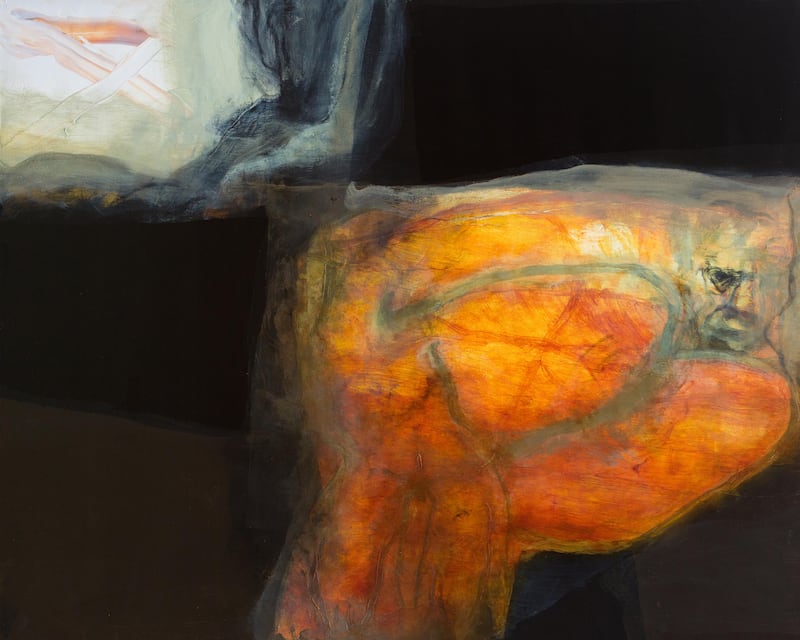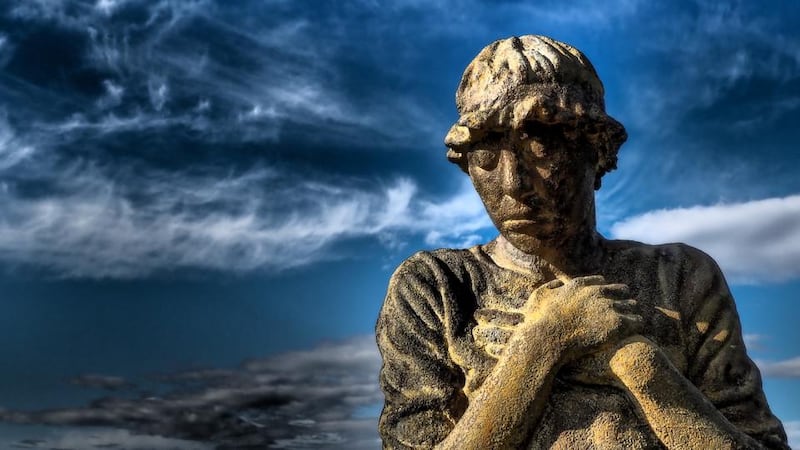In October 2017, during his State visit to Australia, President Michael D Higgins unveiled Footsteps Towards Freedom, a memorial in Hobart to Irish convict women who were sent to Van Diemen's Land, as Tasmania was then known, in the 19th century. Sculpted by Rowan Gillespie, it was the third set of figures in his Famine trilogy, following those on Custom House Quay in Dublin, from 1997, and the group that make up The Arrival, at Ireland Park in Toronto, from 2007.
Public commemoration always serves as a barometer of present concerns, and these three artworks, each a decade apart, signal the continuing strength of interest in the Famine. They also remind us how the “memory” of the Famine is perpetually evoked, enshrined and examined as cipher for the present – an inversion of its formerly muted place in Irish history – even while its significance remains as elusive and mobile as ever.
The Famine Folios series, published by Ireland's Great Hunger Museum at Quinnipiac University, in Connecticut, and distributed in collaboration with Cork University Press, is very much a product of such concerns. It also epitomises the difficulty of crafting public history texts that effectively distil a complex academic literature into a readable and engaging format. The achievements of this series are, in this regard, very mixed.
The Famine Folios reflect a diverse perspective: folklore, music, poetry, architecture, political science, history, visual art and performance all feature
With each slim folio essentially comprising a single essay, they occupy the other end of the physical spectrum from the Atlas of the Great Irish Famine (2012) and the Atlas of the Irish Revolution (2017), the massive historical compendiums lavishly produced by Cork University Press. But both genres feature a mixture of authors presenting new and revisited scholarly material, heavily illustrated and accessibly designed. Unfortunately the folios' value as individual publications is more variable, as they never quite commit to either a popular or academic readership, and their quality is uneven.
Under review here are the latest eight in the series of 16 Famine Folios so far. One of the most remarkable recent developments in Famine studies has been an intense interdisciplinarity, and the folios reflect this diversity of perspective, as Famine folklore, music, poetry, architecture, political science, history, visual art and performance all feature.
A number of the folios engage originally and provocatively with their topics. Breandán Mac Suibhne's Subjects Lacking Words? The Gray Zone of the Great Famine (44pp, €11.95) is the most exceptional, echoing his groundbreaking monograph The End of Outrage: Post-Famine Adjustment in Rural Ireland, also from 2017. Here Mac Suibhne presents a nuanced take on "survivors" of the Famine and those who occupy the "grey zone" – a term borrowed from Primo Levi's memoirs of the Holocaust – a liminal space where distinctions between perpetrators and victims blur, created in conditions of extreme depravation where communal standards of behaviour are violated in a desperate bid for survival.
Breandán Mac Suibhne poses challenging questions about how societies remember or rehabilitate horrific experiences absent clear moral absolutes
Mac Suibhne poses challenging questions about how societies remember or rehabilitate horrific experiences absent clear moral absolutes. In so doing he revisits territory similarly covered by Cormac Ó Gráda, most recently in Eating People Is Wrong, and Other Essays on Famine, Its Past, and Its Future, from 2015, and echoes other microhistorical investigations of internecine conflicts, such as Strokestown and the Great Irish Famine, Ciarán Reilly's work on the Roscommon estate, from 2014, and Ciarán Ó Murchadha's Figures in a Famine Landscape, from 2016, which focused on west Co Clare.
Niamh Ann Kelly's Ultimate Witnesses: The Visual Culture of Death, Burial and Mourning in Famine Ireland (48pp, €11.95) also presents a well-written and lucid account of pre-Famine and Famine-era mortuary practices and their visual representation. Informed by an excellent range of sources, many drawn from the National Folklore Collection at University College Dublin, she explores the rituals of death and burial disrupted by the mass shock of the Famine. Infused with (but not overdetermined by) cultural theoretical perspectives, she offers sensitive readings of mass-grave sites and their subsequent commemoration. Well-chosen illustrations, closely examined in the text, add force to her arguments.
Indeed, one of the most impressive aspects of some of the folios is their use of copious illustration and careful eye for captioning. (Unfortunately, others tend to include images that have no clear relationship to the text, or that are unhelpfully cropped.)

Paschal Mahoney's Grim Bastilles of Despair: The Poor Law Union Workhouses in Ireland (52pp, €11.95) is a solid survey of the Irish workhouse system and the career of its English architect, George Wilkinson, although his commentary on the Irish Poor Law would have benefited from consulting the extensive work in this area by Peter Gray and Virginia Crossman. An architect himself by training, Mahoney offers astute, insightful analyses of Wilkinson's designs, basing them on plans and drawings from the collections of the Irish Architectural Archive and extant workhouse examples. Parallels between the horrors of the 19th-century workhouse system with 20th-century institutions of confinement and reform, such as Magdalene laundries and industrial schools, are inescapable; Mahoney's text is a reminder that many such buildings continue to slip under the preservation threshold, and face uncertain futures.
Two of the other folios would best suit a general audience, as they are not conversant with (or opt not to include) recent scholarship in their areas.
In Leaves of Hungry Grass: Poetry and Ireland's Great Hunger (52pp, €11.95), the poet Vincent Woods offers a "personal and particular" patchwork of "the poetry of restorative memory, the work of Irish and international poets who seek to reimagine the Famine past, pay witness to its victims and survivors, and forge links to a wider world of suffering humanity". Its assembly of examples culminates in a newly commissioned poem by Eiléan Ní Chuilleanáin, Maria Edgeworth in 1847.
Mick Moloney's Across the Western Ocean: Songs of Leaving and Arriving (56pp, €11.95) is an interesting compendium and CD of 19th- and early-20th-century songs on Famine-related themes such as eviction, emigration and conditions of immigrant life. Anti-immigrant songs from the Know-Nothing movement provide intriguing counterpoints to nostalgic balladry, with nativist lyrics like "Yankee Doodle wide awake / Be silent you should never / Until you drive the popish snake / From off the soil, forever" echoing Trumpian rhetoric. The author's expertise on this topic is unfortunately rather short-changed in a text dominated by reproduced music and lyrics rather than discussion and analysis.
We may be more sanguine about the perils of conflating history writing with blithe notions of a 'shared cultural memory' than was the case 30 years ago
The three remaining folios required a stronger editorial hand.
Angela Bourke's Voices Underfoot: Memory, Forgetting, and Oral Verbal Art (44pp, €11.95) is fragmented in its treatment of "oral history and verbal art", and examples ranging from David Thomson's memoir Woodbrook, from 1974, to soup pots do not entirely cohere into a focused account of folk memory and the Famine. Its opening statement that the Famine "had scarcely been spoken of in Ireland for twenty-five years" preceding the 150th anniversary is contradicted by several of the other folios, as well as existing historiography.
Tadhg Foley's Death By Discourse? Political Economy and the Great Irish Famine (48pp, €11.95) misses the opportunity to present a readable summary of the oppressive economic and philosophical ideologies of modernisation that led to disastrous state responses to crisis, particularly under the Russell government from mid-1846. The essay appears to be condensed from Foley's previous collaborative works with Thomas Boylan, published in the 1990s, but here lacks a clear chronology and historical context.
Richard Kearney and Sheila Gallagher's Twinsome Minds: An Act of Double Remembrance (48pp, €11.95) has little to do with the Famine at all, as a "published version of a multimedia performance" commemorating the Easter Rising originally staged at the Abbey Theatre in 2016. The authors claim that the failure of the 1916 leaders to explicitly refer to the Famine as "the direct cause of rebellion" (which was unsurprising, as it wasn't) was "symptomatic of an unconscious repression of inherited trauma", an assertion with no basis in evidence. What follows is an attempt to model what the authors distinguish as "good" commemoration from the "bad" type, deeply indebted to fuzzy pseudo Freudian notions of post-traumatic "healing" and recovery.

This final folio indeed feels like a throwback to the ubiquity of such framings of the Famine in the 1990s, which Mac Suibhne’s own folio aptly critiques, noting how “narratives like those of [Hugh] Dorian and [Jeremiah O’Donovan] Rossa and, indeed, stories told by the generation that came after them give the lie to the facile notion, popularized in the 1990s, that the Famine was ‘so deeply tragic as to be too traumatic to recall’.”
The field of Famine studies has certainly advanced to a point where we may be more sanguine about the perils of conflating history writing with blithe notions of a “shared cultural memory” or undifferentiated “cultural trauma” than was the case 30 years ago, a myopia the Famine Folios series does not always avoid.
Serious students or scholars of Irish studies will prefer its authors' more rigorous and extended engagements with their subjects elsewhere, although the folios' standards of design and visual interest are admirable and bode well for the imminent Irish tour of Art & the Great Hunger, from Quinnipiac's art collection, which features heavily throughout.
Dr Emily Mark-FitzGerald is associate professor of art history and cultural policy at University College Dublin. She is author of Commemorating the Irish Famine: Memory and the Monument (Liverpool University Press, 2013) and coeditor of The Great Irish Famine: Visual and Material Cultures (also Liverpool University Press, forthcoming 2018)
Art & the Great Hunger, from the collection of Ireland's Great Hunger Museum, at Quinnipiac University, opens at Dublin Castle in March, then moves to Skibbereen in July and Derry next January; artandthegreathunger.org










